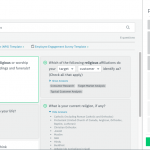Inclusion is an important part of cultivating a diverse workplace and addressing systemic inequality across industries. It’s also key to building stronger surveys.
Inclusive surveys are rooted in empathy, respect, and clear goals—from their language to their accessibility. You create an inclusive survey when you’re conscious of how you ask about sexual orientation and gender identity, religion, or when you consider your respondent experience from many perspectives. When you make these kinds of choices and prioritize inclusion, it makes a big difference for your surveys’ impact. You'll pave the way for richer data, ensure that respondents feel valued, and reflect your organization’s commitment to diversity, equity, and inclusion.
Now how do you make sure your surveys are inclusive? While there isn’t a fixed formula, here are some important principles to keep in mind:
Be thoughtful about demographic questions
Demographic questions ask about the background characteristics of your respondents, including things like age, gender, sexual orientation, and race. These questions help you get a clearer understanding of your audience, but digging into identities related to diversity, equity, and inclusion can feel personal. That doesn’t mean you should steer clear of these questions—but you should know why you’re asking them and how you’ll use the data. Being clear about this will help you create better, more intentional questions.
For example, perhaps you’re looking to use this yes or no question from the Gallup tracking survey: “Do you personally identify as lesbian, gay, bisexual, or transgender?” While this may get you an overall estimate of LGBTQ individuals, it won’t take into account those who identify as both transgender and straight. If you want to understand your respondents’ identities with that level of specificity, you’ll need to approach this question in a more inclusive way.
Of course, when you’re asking about racial, religious, or gender identities, there’s always the risk that your respondents won’t identify with any of your answer options. One way to avoid this, and make demographic questions feel more inclusive, is to include a fill-in-the-blank option that gives respondents the power to write in their own answer. This will allow them to be “seen” and may even give you ideas for future answer options.
Be open about why you’re asking demographic questions
While many respondents will happily answer demographic questions, others may feel more comfortable sharing that information if they understand why you’re asking and how their responses will be used. You can easily provide some context with a survey introduction that explains your survey’s topic and purpose. A bookstore asking its survey respondents’ about their race or religion may receive more responses if there is some indication that it will use the data to stock merchandise or plan community programming that’s relevant to its customers.
Don’t make survey questions required
When taking a survey, nobody likes being forced to face an uncomfortable question. In fact, our research found that 27% of respondents say that not being able to skip a question is enough to make them quit a survey. And if a lot of people quit, your results will suffer. You’ll end up with less data, and what you do get is more likely to be homogeneous and therefore less valuable.
Instead of requiring all your survey questions, give respondents the freedom to skip questions. This simple act will respect their boundaries, keep them engaged, and decrease the chance of survey fatigue.
Use skip logic
Skip logic allows you to send respondents to a certain question or page based on how they answer a particular survey question. Using this survey feature creates personalized survey experiences where respondents only see questions that apply to them. This is especially helpful when building inclusive surveys.
For instance, let’s say a survey asks respondents for their religious affiliation and a respondent selects “Hindu.” If that respondent is then asked about their favorite Christmas tradition or how frequently they attend church, they're likely to feel ignored or unwelcome. They may even quit your survey at the first sign of irrelevant questions.
You can use skip logic to tailor their survey experience and make sure respondents feel that their time and their answers are valued. Plus, this feature will help you gain a better understanding of respondents’ backgrounds and experiences so you can build future surveys based on those insights.
Be mindful of language
Language is powerful and everyday words and phrasing can inadvertently exclude, offend, or marginalize certain people. To avoid this in your surveys, it’s important for your questions to use inclusive language. As the Linguistic Society of America explains, this is language that “acknowledges diversity, conveys respect to all people, is sensitive to differences, and promotes equal opportunities.”
There are lots of ways to put that into practice. Here are a a few guidelines to ensure your survey language is inclusive:
Think about context, history, and implications
We’re not always aware of how common words and phrases are perceived. For example, a cell phone provider surveying its customers about a “grandfather clause” that will affect their phone plan might not realize that there is a racist history behind that term.
Be on the lookout for words or phrases that could carry unintended connotations, so you can swap them out for more specific wording. It’s also best to avoid idioms, slang, or words that might carry different meanings for different groups of people.
Don’t define what’s “normal”
As you write survey questions, try not to center certain ideas or identities as “normal.” One example of this is the “generic he.” This is when male words or pronouns are used as a “neutral” way to communicate, like if a survey asks respondents about their manager and whether he promotes a supportive work environment. (To learn more about using non-sexist language, check out the guide from The American Philosophical Association.) Another example is assuming that your respondents have a college degree, a job, or a house—privileges that may not apply to your entire audience.
Rely on expert resources
Is there something you want to ask but you’re not sure how to phrase it? Consulting resources like the Racial Equity Resource Guide or the Conscious Style Guide is a good way to double-check your language. You can also rely on the ready-to-go questions in SurveyMonkey’s question bank. They cover a variety of tricky topics, including race and religious affiliation, and they’re all written and certified by our very own survey methodologists.

Remember, it’s always a good idea for you and your collaborators to preview your survey before sending, especially if you want to confirm that your language is objective and respectful. Your collaborators will bring new knowledge and perspectives as they review your questions and they may catch things that you won’t.
Design your survey with accessibility in mind
There are lots of simple but powerful things you can do to make your surveys accessible to a wider range of people. Write for accessibility by making your survey questions clear and concise. If there is information that respondents only get from looking at an image, try to include context in the text of the question. If you’re customizing your survey with colors and design features, make sure the color contrasts are readable and try to make your design as inclusive as possible. And before you finalize your survey, review it with our accessible surveys checklist.
We hope these tips help you establish a baseline for creating more inclusive surveys. Keep in mind, there’s always more to learn about thinking, and surveying, inclusively.
If you’re looking for additional support for your organization’s diversity, equity, and inclusion goals, check out our Diversity & Inclusion Guide and racial equity resources. You’ll find tips, discounts, and expert-designed inclusive surveys that address common DEI issues in the workplace.



